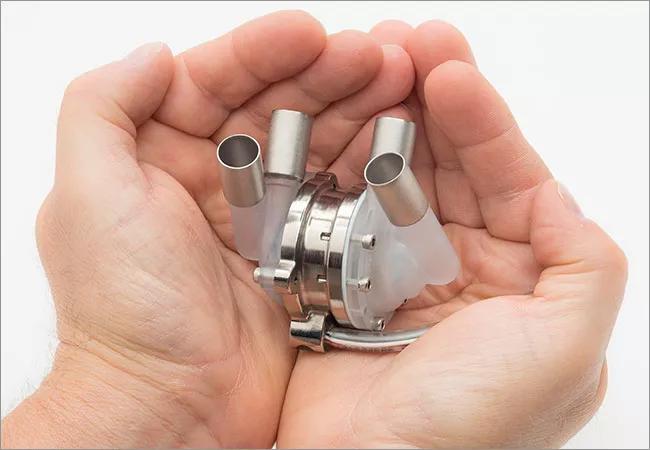Advances in in vivo models continue

In 2017, Cleveland Clinic researchers were the first to demonstrate successful implantation of a pediatric continuous-flow total artificial heart (P-CFTAH) in an acute animal study. The device remains under development, and ConsultQD spoke with Kiyotaka Fukamachi, MD, PhD, Director of the Cardiovascular Dynamics Laboratory in Cleveland Clinic’s Department of Biomedical Engineering and principal investigator of the study, to learn what’s next.
Advertisement
Cleveland Clinic is a non-profit academic medical center. Advertising on our site helps support our mission. We do not endorse non-Cleveland Clinic products or services. Policy
What are the challenges the team has faced in developing a pediatric-specific tool?
Dr. Fukamachi: Mechanical circulatory support [MCS] is standard for adults with advanced heart failure, but MCS options for pediatric heart failure or congenital heart disease [CHD] patients are limited to a few external devices at best, like temporary extracorporeal membrane oxygenation [ECMO] or percutaneous Impella, among others. The only device currently on the market is too large for smaller children, and is a pneumatic-driven pulsatile device, which lacks reliability and durability.
We don’t use this type of device in adults anymore; we only use continuous-flow rotary ventricular assist devices [VADs]. That’s why we decided to develop the P-CFTAH, which allows for a significant size reduction while forgoing the use of valves or flow sensors for control. This smaller, simpler pump design promises to increase system reliability.
How does P-CFTAH work?
Dr. Fukamachi: We based the P-CFTAH on Cleveland Clinic’s CFTAH for adults, scaled down with size reductions of 30% in all dimensions to allow for implantation in children and infants with a body surface area as small as 0.3 m2, or approximately 5 kg body weight.
The device features a dual-pump design unified in a single, continuously rotating brushless DC motor and rotor assembly supported by a hydrodynamic bearing. The sensorless design can produce pulsatile flow with speed modulation and automatically balance left and right circulations without electronic intervention.
Advertisement
Describe the results of early in vivo experiments.
Dr. Fukamachi: Our first study, which we presented at the American Heart Association (AHA) Scientific Sessions in 2017 and published in 2018, confirmed in four lambs the P-CFTAH’s self-regulating performance, including pump speed, flow and current. We also confirmed its ability to maintain standard hemodynamic measures and good left and right atrial balance in response to manipulations of systemic and pulmonary vascular resistance. There were no pump failures.
We were very pleased with the prototype implantation, and this early testing validated the feasibility of the dimensional scaling of the device in terms of size and performance.
What’s the next step for your team?
Dr. Fukamachi: I am confident that our P-CFTAH will overcome size and durability challenges inherent in developing this type of device, but there are many other challenges to face, including the small market for pediatric devices. One solution for this is to use P-CFTAH in adult patients as a biventricular assist device (BiVAD), which would increase the market size. We are fortunate to have received government funding, but that continued support is essential to develop the device further. We continue to test the P-CFTAH to address the challenge universal to all MCS devices of long-term biocompatibility. We are performing computational fluid dynamics analysis, in vitro testing on the bench, and in vivo animal experiments.
When do you hope to see the first clinical trials of this device?
Advertisement
Dr. Fukamachi: This is a tough question to answer, because there are many challenges to be overcome before the first clinical trials. We’re working as quickly as possible so that this device can help many pediatric patients with heart failure soon.
Advertisement
Advertisement

Integrated care model reduces length of stay, improves outpatient pain management

A closer look at the impact on procedures and patient outcomes

Experts advise thorough assessment of right ventricle and reinforcement of tricuspid valve

Study also finds that 26% of children with cancer have mutations in DNA repair genes

A closer look at current uses and future opportunities

Experts are challenging the one-size-fits-all paradigm

Quality improvement project addresses unplanned extubation

Cardiac imaging substudy is the latest paper originating from the VANISH trial